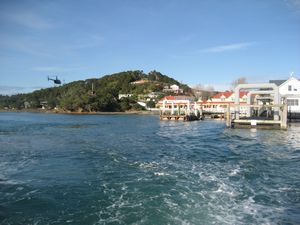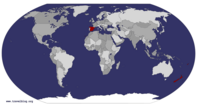Advertisement

 Pahia
Pahia
Returning from the Rock overnight cruise.Northland:
Paihia- Maori meaning place of many pas (hill forts). Once there were many tribal wars. Every time blood was spilt, the tribes left the pa to find another. While built for defence, the main function of most pā was for the safe storage of food in pits, especially kumara, a sweet potato. They would dry out the kumara and bury it, then as they travelled they could always source food.
These days Paihia is a bustling tourist town, with a ferry to Russell. the old capital of NZ, population of 2000 which rises to 70, 000 in the summer months. Paihia is the gateway to the Bay of islands and Cape Reinga, the very top of the North island.
Russell, these days is a sleepy small town with around 1000 people. It has an interesting museum, but further up the street is the French Pompallier catholic missionary house. Set up by Bishop Pompallier, it contains a wonderful tannery, where the process of taking meat carcases to the refining of the hides used to cover the bibles translated into Maori were made. The Parisian printing press is also still there. These bibles, painstakingly created were handed out FREE to willing

 Pompallier Mission House
Pompallier Mission House
Notice how tall the poinsettia is!converts. The easiest job was the sciver(perhaps the origin of skiving). He or she shaved the leather to smooth it down for the covers. 40, 000 religious texts were made in 8 years! It was NZ's first factory.
History:
According to tribal narratives, Kupe was the first Polynesian to discover the islands of New Zealand. His journey there was triggered by difficulties with fishing in Hawaiki, his homeland. Apparently the problem was a great octopus belonging to Kupe’s competitor, Muturangi. Kupe set out in his canoe to kill the octopus, and such was the length of the pursuit that it brought him to New Zealand. He first arrived in the Bay of Islands and it is said that his wife, Kuramārōtini, devised the name of Ao-tea-roa (‘long white cloud’) on seeing the North Island for the first time.
Rich in resources, the Bay of Islands attracted early Polynesian settlers and was occupied for centuries by competing Maori tribes. In the late 18th century, European explorers Cook and 2 years later, Du Fresne visited the Bay. Whalers, sealers and traders set up bases there and Christian Mission stations were established. Trade in muskets made inter tribal wars more deadly.
By

 Waitangi Treaty House
Waitangi Treaty House
The most famous, historical place in NZ1830, the Bay was crowded with visiting ships. The trading centre at Kororareka (Russell) had an unsavoury reputation as the "Hell hole of the Pacific" Disturbed by reports of lawless behaviour the British government appointed James Busby as British Resident in NZ.
Busby arrived in Paihia in 1833 and settled at Waitangi. Without resources to enforce his authority Busby was described by Maori as a "man-o-war without guns" but did amazing work as a mediator. In 1834 he helped the Northern chiefs to obtain a maritime flag and registration for locally built ships In 1835 he hosted a gathering of 35 northern chiefs who signed the declaration of Independence of New Zealand. The Maori people probably didn't really understand the full effects of British sovereignty, but the Treaty, signed in Busby's house, from then on known as the Treaty House brought the 2 people's together as a nation.
Busby himself is an interesting personality. He emigrated to Australia from Edinburgh at the age of 22. In Australia he is known as the father of viniculture as he took the first collection of vine stock from Spain and France to Australia.After teaching locals about viniculture he was allowed to choose a

 Te Whare Rananga
Te Whare Rananga
Maori meeting house at Waitangi. Kupe is at the top of the housepiece of land in the Hunter Valley. He then began producing wine in his home in Waitangi!
No visit to the Bay can go past without visiting the Kawiti Glow Worm Caves owned by a few generations of the Kawiti family.
George gave us a 30 minute guided tour along a wooden boardwalk through a 200 metre limestone cave system. Once inside, we saw thousands of glow worms spread across the ceiling surrounded by breath taking stalactites and stalagmites. As well as eels, swimming in the riverbed underneath the boardwalk.
You can't take photos in the cave as the bioluminescence stops when light is shone directly onto it. At times, George turned the lantern off and we saw the galaxies of glow worms above, he explained the life cycle of the New Zealand Glow worm (Arachnocampa Luminosa) and the intricate webs used to catch their prey. we got close enough to see the actual body of the glow worm and its stunning blue/green tail light, and at the end of the trail were able to see some wetas sheltering from the cold in a crack in the rock! I was prepared to have avoided the wetas (NZ insects
a bit like a grasshopper- but bigger), which really only make appearances in the height of summer, but here we were, a safe half metre away from an entire family!
From the caves, we took a trip to Kawakawa to see the Bay of islands Vintage Railway. This began in 1864, with the discovery of coal in Kawakawa. A tramway was built four years later, using horses to get the coal to the Kawakawa River at Taumerere, nearly 4km away.
The old tram tracks – 4'8 ½" gauge –were soon replaced by the present rail line, and it was the first railway line to be opened in the North Island, in 1877. The link through to Opua was completed in 1884, and led to the development of Opua as a deep-sea port.
What a journey! Right through the centre of town in Gabriel, the steam engine. Traffic must stop by law for the train.
Kawakawa is also famous for being the home of Frederic Hundertwasser, the Austrian architect!! In 1998 the Kawakawa Community Board was looking to upgrade 40-year-old toilet facilities in the central township, and Hundertwasser offered a solution from his design palate. To Hundertwasser, a toilet is very

 Kahoe Farm
Kahoe Farm
It finally started raining here!special because you meditate in a toilet, like a church. We had to go and see the toilets while in the area. Hundertwasser fans (like us) have been flocking ever since and put Kawakawa on the map! That's the really interesting thing about small towns in NZ, they attract tourists to them for a novelty reason- eg. the history of Arrowtown, Taihape the Gumboot town, and, one place we haven't been but home to the wierd phenomenon of Steampunk in NZ is Oamaru. I reckon Scottish towns could run with this. Anyone got any novelty ideas for Bathgate and Falkirk???... ? Enough of the surreal...
Cape Reinga:
Cape Reinga (Te Reinga or Te Rerenga Wairua in Māori is the northwesternmost tip of the Aupouri Peninsula, at the northern end of the North Island of New Zealand. Cape Reinga is located over 100 km north of the nearest small town of Kaitaia.
The name of the cape comes from the Māori word 'Reinga', meaning the 'Underworld . Another Māori name is 'Te Rerenga Wairua', meaning the leaping-off place of spirits. According to Maori mythology, the spirits of the dead travel to Cape Reinga on their journey to the afterlife to leap
off the headland and climb the roots of the 800 year old tree and descend to the underworld to return to their traditional homeland of Hawaiki, using the Te Ara Wairua, the 'Spirits' pathway'. At Cape Reinga they depart the mainland. They turn briefly at the Three Kings Islands for one last look back towards the land, then continue on their journey to their homeland. The cape certainly feels spitirual. It is also the place where the Tasman and Pacific oceans meet, the waves crashing directly into each other.
The entire peninsula is a protected area, an untouched spit of sand and dunes. Wild horses run on the beach. At various times in it's geological evolution it has been above and below the sea level. Thus there are buried Kauri trees from 50 000 and 150 000 years old, preserved in the peat soil of the area. Similar to Scottish peat in it's preservation qualities but, unfortunately not suitable for burning on a fire. This peat has preserved the Kauri and was untouched until the 1840s when people discovered amber - sap from the trees, and began digging pits. These people were called gum diggers and the boots they used
were called gumboots- the NZ name for wellies.
We returned to Paihia via Ninety Mile beach(actually 63 miles long).The bus drives down the beach.
Bay of Islands: We took an overnight cruise on the Rock, a floating hostel with lots of fun activities to enjoy. First up a shooting competition of the back of the boat. Next some night fishing for snapper, alas it was the one that got away- you felt them nibbling around the bait, but that was it! Fortunately the barbecue had a nice steak cooking on it! Later, we went night kayaking looking at the bioluminescence that we had seen off the boat in Fiji- didn't really see much of it in the Bay!
The next day we sailed to a beautiful island, where I did something I've never done before- hiked up a hill in bare feet. Mud was cold and the grass lovely, soft and warm- would recommend- in the right place!
Later there was some kayaking to be done and snorkelling. A really good way to spend 22 hours.
Advertisement
Tot: 0.07s; Tpl: 0.012s; cc: 14; qc: 29; dbt: 0.0311s; 1; m:domysql w:travelblog (10.17.0.13); sld: 1;
; mem: 1.1mb






















